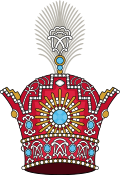Rana (title)
Rana (Sanskrit: राणा) is a historical title denoting an absolute Hindu monarch[citation needed] in the Indian subcontinent. Today, it is used as a hereditary name in the Indian subcontinent. "Rana" was formerly used as a title of martial sovereignty by Rajput kings in India.[1] Rani is the title for the wife of a rana or a female monarch. It also applies to the wife of a raja. Compound titles include rana sahib, ranaji, rana bahadur, and maharana.
Usage in the Indian subcontinent[]


"Rana" was formerly used as a title of martial sovereignty by Rajput kings in India.[1] Today, members of some Rajput clans in Indian subcontinent use it as a hereditary title. In Pakistan, mostly Muslims—but also some Hindus in Sindh (present-day Pakistan)—use it as a hereditary title.[2] Umerkot, a state in Sindh, has a Hindu Thakur Sodha Rajput ruler who uses the title.[3]
In the 16th century, Rana Prasad, the monarch of Umerkot, gave refuge to the Mughal prince Humayun and his wife, Hamida Banu Begum, who had fled from military defeat at the hands of Sher Shah Suri. Their son Akbar was born in the fort of the Rana of Umerkot.[4]

The head of the Kunwar nobles of Nepal, Jung Bahadur Kunwar, took the title of Rana(ji) and Shree Teen Maharaja after consolidation of his post of Prime Minister of Nepal. This dynasty controlled administration of the Kingdom of Nepal from 1846 until 1951, reducing the Shah monarch to a figurehead and making Prime Minister and other government positions hereditary.[5][6]
References[]
- ^ Jump up to: a b Bhattarai, Krishna (2009). Nepal. Infobase Publishing. p. 42. ISBN 9781438105239.
- ^ "Rajput appeal from Amarkot". The News International, Pakistan. 24 July 2013. Retrieved 10 September 2015.
- ^ P B Chandra (10 August 2009). "Rana kin in Pakistan for mourning". The Times of India. Retrieved 5 September 2021.
- ^ "Umerkot's former Rajput ruler is dead". The Hindu. Retrieved 5 September 2021.
- ^ Dietrich, Angela (1996). "Buddhist Monks and Rana Rulers: A History of Persecution". Buddhist Himalaya: A Journal of Nagarjuna Institute of Exact Methods. Retrieved 5 September 2021.
- ^ Lal, C. K. (16 February 2001). "The Rana resonance". Nepali Times. Retrieved 5 September 2021.
- Royal titles
- Titles in India
- Titles in Pakistan
- Titles of national or ethnic leadership
- Cultural history of India
- History of Pakistan
